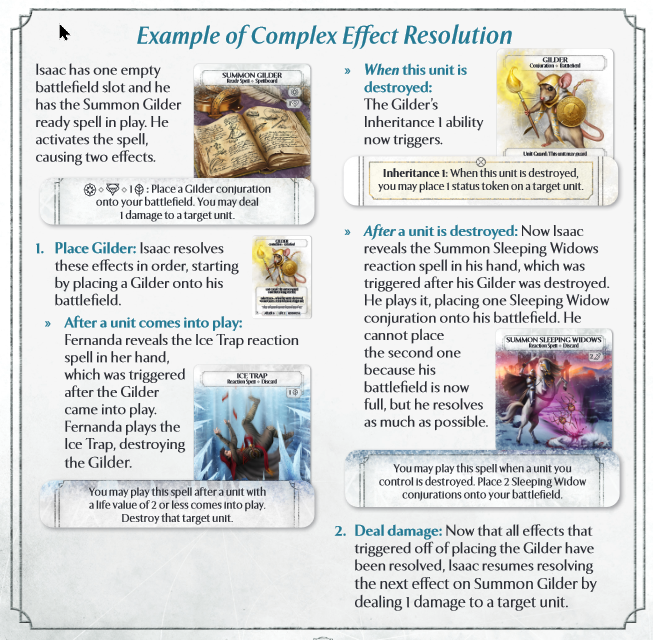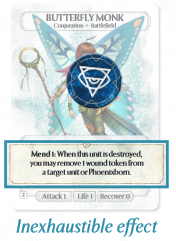Resolving Effects
There are four rules when playing cards or resolving effects:
- Resolve the card text from top to bottom, one effect at a time.
- Resolve as much of each effect as possible.
- Resolve each card completely, even if it is removed from play.
- Card text always supersedes game rules.
A card can have multiple effects, and they will be separated either by periods or by the words “to” or “and.” If an effect on a card triggers another effect, pause resolving the current card until all related triggered effects have been resolved.
Example of Complex Effect Resolution

Damage, Wound Tokens and Destruction
When a unit, Phoenixborn or Chimera is dealt damage, place a number of wound tokens on it equal to the amount of unprevented damage it received. After a unit, Phoenixborn or Chimera has a number of wound tokens equal to or greater than its life value, destroy it.
- When a unit is destroyed, it is discarded.
- When an aspect is destroyed, after it is discarded, place a number of wound tokens on the Chimera equal to that aspect’s blood value.
- When a Phoenixborn is destroyed, its controlling player loses the game.
- When a Chimera is destroyed, the player(s) win the game!
Note: A card’s life value is not reduced when wound tokens are placed on it.
Note: Deal damage -> Place wounds -> Destroy.
An effect that “deals damage” places wound tokens and destroys, but an effect that “destroys” does not deal damage or place wound tokens.
Discarding Cards
When a card in play is discarded or otherwise removed from play, set it aside along with any cards underneath it that are attached or face down. After resolving any triggered effects, return any tokens on any of these cards to the supply, discard the cards that are underneath, and place that card in its final destination. Discarded cards go to their owner’s discard pile.
Exception: Discarded conjurations and conjured alteration spells do not go to a discard pile but return to their owner’s conjuration pile.
Exhaustion Tokens
Some game effects place exhaustion tokens on cards. When a card has 1 or more exhaustion tokens on it, it is considered to be exhausted. An exhausted card has no ability or effect text though it retains everything else including attack, life, and recover values (on units), and value bonuses (on alteration spells). In addition, exhausted units cannot attack, block, guard or counter.
Some cards have inexhaustible effects or abilities, indicated by a yellow box. These effects or abilities remain even if the card is exhausted. In this example, an exhausted Butterfly Monk does not have the Unit Guard ability but it retains the Mend 1 ability as well as its attack, life, and recover values.
Status Tokens
Status tokens can have various effects based on the cards that are in play. Those cards will detail how the status tokens are to be used.
ADVANCED TIMING CONSIDERATIONS
The rules in this section deal with the precise timing of certain game effects. Ashes can be enjoyed in a casual setting without reading these rules. In certain settings, however, the precise order of resolution is important.
Attack Resolution
During an Attack action that targets a Phoenixborn, an attacker or blocker may be exhausted or destroyed before their battle begins to resolve.
- If an attacker is exhausted or destroyed, it leaves battle and does not attack.
- If a blocker is destroyed, the attacking unit is no longer blocked and will deal its damage to the target Phoenixborn.
- If a blocker is exhausted, it still blocks but cannot counter (deal damage) and does not receive an exhaustion token.
Damage Resolution
Whenever damage is dealt, wound tokens are placed, or units are destroyed, enter the process below at the appropriate step. If damage of 0 is dealt, do not enter the process and do not trigger any effects.
Step 1: Deal Damage.
» Effects that trigger “after damage is dealt” may now be used. Most of these effects will prevent 1 or more damage from being received in step 2.
Step 2: Receive Damage and Place Wounds.
Place wound tokens equal to the damage received.
- If a unit has wound tokens on it equal to or greater than its life value, it will be destroyed in the next step.
- If a Phoenixborn has wound tokens on it equal to or greater than its life value, its controlling player immediately loses the game.
» Effects that trigger “after 1 or more wound tokens are placed” may now be used.
Step 3: Destroy Unit. Remove unit from play.
» Effects that trigger “when this unit is destroyed” may now be used.
» After all of the above effects have resolved, effects that trigger “after a unit is destroyed/leaves play” may be used.
Step 4: Discard the Destroyed Unit.
Simultaneous Effects
Sometimes game effects will seem to occur simultaneously. Here is how to properly order those effects.
Effects with the same trigger timing
If players have 1 or more responses to the same triggering game event, each player (starting with the Active Player—the player whose turn it is) has one opportunity to play any cards and activate any effects they wish to in response to that trigger, resolving them one at a time and then passing the opportunity to their opponent.
Effects that trigger “when” a game event occurs
Some effects occur “when” a game event occurs, e.g. “When this unit comes into play, you may deal 1 damage to another target unit.” In this case, complete the triggering game event (“unit comes into play”) and then resolve the triggered effect (“deal 1 damage”) along with any other effects with the same trigger timing as detailed above. After all “when a unit comes into play” effects are fully resolved, “after a unit comes into play” effects can now trigger.
Example: An Anchornaut with the above example ability comes into play. You may then deal 1 damage to a target unit. After that damage is fully resolved, and no player chooses to activate any other “when” effects, your opponent could play the reaction spell Ice Trap (“after a unit... comes into play”) and destroy the Anchornaut.
Units that deal damage to each other
Units that deal damage to each other, most commonly when attacking and countering, deal damage simultaneously. The Active Player then chooses which damage to resolve first, using the damage resolution process.
Effects that affect multiple units or other game elements (e.g. spells, cards, etc.)
Some effects can affect multiple units at once, e.g., “Deal 1 damage to all units.” In these cases, the player who controls the effect:
- Selects all units to be affected.
- Resolves the effect for one unit at a time in the order of their choice.
The resolution process may cause a selected unit to no longer fit the selection criteria, or may cause new selectable units to appear. In all cases, the original selection cannot change.
Example: Fernanda plays Mist Typhoon and deals 1 damage to each unit controlled by an opponent. She destroys one of Isaac’s units and he reacts with Summon Sleeping Widows and places 2 Sleeping Widow conjurations into play. These new units will not be dealt damage from Mist Typhoon.

